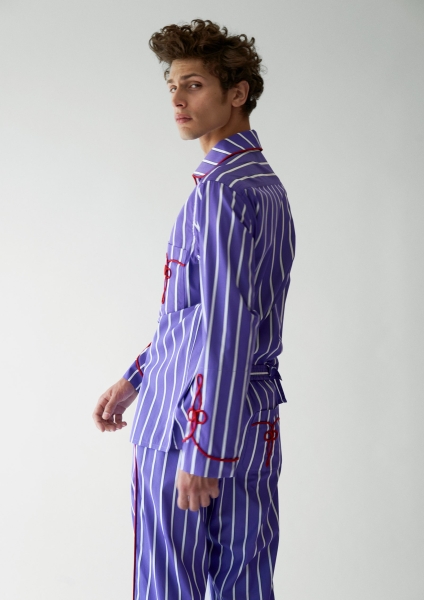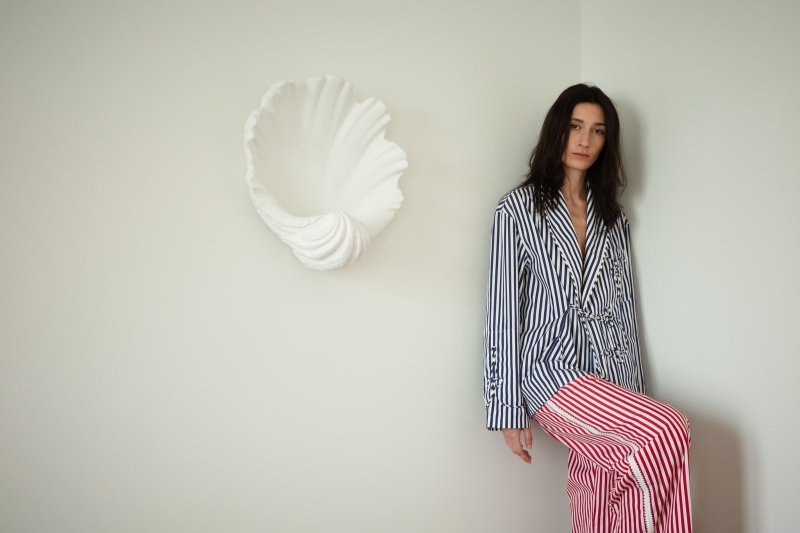
“I love the idea of being a shirtmaker,” says Charles Sebline. “I think that being a fashion designer today is the most impossible thing—it can feel like it goes against the grain of everything I love.” He started to laugh, then went on: “I’m very happy to do just one thing." That one thing that Charles Sebline does for his eponymous brand, Sebline, is to make some of the most sublime shirts out there—shirts which conspire to both celebrate and subvert the sartorial language of one of the most universal pieces in our wardrobes. “There’s a certain classicism to what I am doing,” he says, “but I really try to turn on its head." In many ways, his shirts are just like him. Sebline is Anglo-French, with a British mother and a French father; fashion-schooled in London, worked for much of his career in Paris. Duality comes naturally to him, and his work is no different: Masculine and feminine, sobriety and dandyism, rigor and flourish—they all coexist harmoniously.

Soon after he launched Sebline in 2019, after a career that ranged from interning at Vivienne Westwood at the height of her mid-90s Anglomania era to working for Tom Ford at YSL—along with the master himself, Monsieur Yves Saint Laurent—his shirts acquired a cult-like status. (Today they’re sold at Kirna Zabête and Net-a-Porter.) In part, that’s down to their androgynous appeal, but it’s also due to their gorgeous fabrication—usually a compact, two-ply cotton poplin, which ages beautifully and which looks fantastic when it is simply washed and left to dry—to hell with using a steam iron. (As an avowed non-presser, this was music to my ears.) His easy and confident handling of color also comes into play: There is, of course, a classic palette of white, pale blue, navy, and black, but this fall they will be joined by both olive and a purple shade that Sebline called “papal pink.”
Those colors stood out on a recent visit to see that fall 2024 collection, which Sebline was showing out of his light and airy fourth-floor apartment a cuff-link’s throw away from the Musée Rodin on Paris’s Left Bank. What also caught the eye: A series of shirts, solid-colored, some in the declarative primary color stripes that Sebline loves so much—“visual boldness” is a phrase he returns to again and again—with a crewel-like yarn stitching in bright, contrast colors running along the edge of collars, or up and down the seams, bringing the different components of the shirts together. Others had frogging—an olde-worlde technique redolent of hussar uniforms, applied here to pieces with a casual quality that works well with that kind of intricate detailing. (Both the yarn embroidery and the frogging are relatively new for Sebline.)

The stitching work is being done by a collective located outside of Marrakech meant to create economic support for women in that community. It’s pretty ambitious in the precision of its execution, and Sebline is full of admiration and respect for their work. “It’s dreamlike,” he says. “It’s wonderful: The idea of their embroidery literally bringing the clothes together because of how they are constructed. The stitching they do—it’s not only functional; it’s also incredibly decorative.”
Much of Sebline’s appreciation for handwork comes from the uniqueness of his trajectory through the fashion world. He alighted at Westwood after the label’s founder came to speak at his alma mater, Central Saint Martins. They chatted after her talk and discovered a shared love of Yves Saint Laurent—and the next day, Westwood called up his school and asked if he would intern. He was with the designer for three seasons, and Westwood was, says Sebline, “very supportive and generous—Vivienne asked me what she could do to help, and I showed her some sketches I’d drawn. She told me, ‘I think you should go to Paris and work.’” That time—and that advice—crystalized one thing for him. “I know it’s terrible to say,” Sebline says, “but I was a bit disenchanted with Saint Martins: I was really irritated not to be learning how to sew, how to cut. I had no idea if what I was designing could ever be made.”

Off to Paris he went—interning, at first, with Azzedine Alaïa, before ending up working for Monsieur Jean-Pierre, who was head of tailleur at Yves Saint Laurent, and getting valuable advice from the formidably stylish Loulou de la Falaise, who was part of YSL’s inner circle. From the former, he learned valuable skills, like how to sew by hand with a thimble; from the latter, the wisdom that whatever one creates has to make sense. “I showed Loulou some sketches, including one of a jacket with no armhole, and she asked me, ‘Why is there no armhole? You can’t construct that!’” he recalls, laughing. “It was Loulou who said I should work with Mr. Jean-Pierre—I didn’t know how to do anything,” he said. “So I learned how to sew; I began my apprenticeship.”
What Sebline learned still informs his work, yet there’s still room for unexpected moments of inspiration—the kind of randomness that can drive technical accomplishment and ambition even further. Only the other day, he found himself walking behind an elderly gentleman wearing a tweed jacket and corduroy pants—a mode of dressing so far removed from fashion, but so deeply personal and authentic to the man himself that he couldn’t help but be captivated. “I love the idea of making one thing as beautifully as possible,” Sebline says. “I loved seeing that man in his corduroy trousers—I don’t like corduroy at all, but the fact that he was wearing this everyday pair of trousers, with fabric so velvety, so painterly rich… There’s a lot of mileage in that.”

